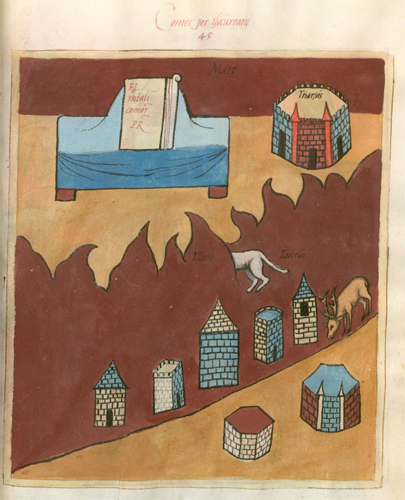
This page created 25 December 2002, and last modified: 30 December 2015 (references rearranged)


|
The following units are listed as being under the command of the Comes per Isauriam (i.e the Count of Isauria; the numbers in front of the names refer to Ingo Maier's numbering scheme):
54.2 Legio secundae IsauraTheir shield patterns are not given.
Disclaimer: Remember, a lot of what comes below is speculation. Hopefully informed speculation, but speculation nonetheless. Comments welcome! (lukeuedasarson "at" gmail.com)
The frontpiece to the left, taken from the Bodleian manuscript (O), shows three larger and five smaller forts, but the only labels refer to natural features: "Tarsium mare" (53.b) and "Mons Taurus" (53.c); the Gulf of Mersin and the Taurus Mountains, respectively. |
As is usual for units under a (non-limital) Comes, garrison locations are not given in the Notitia for either Legio II Isaur[i]a or Legio III Isaur[i]a, presumably since the units were field army (comitatenses) units, rather than limitanei legionary units. On the other hand, the absence of recorded shield patterns fits a limitanei designation better. This would appear to corroborate apparent changes in the nature of the governmental organisation of the province: at 3.14, under the listing of the provinces under the (civil) Praetorian Prefect of the Orient, the Notitia states that the province of Isauria has a Military Count (comes rei militaris; also listed as such at 1/2.37), who thus combines both military and civil powers, as do the Dux et praeses provinciae Mauritaniae et Caesariensis (89.34) and the >Dux Arabiae (3.14). Yet, in the textual list for the officers found under the comes rei militaris (52.1 ff) we find, at (52.13) that it is a Dux Isauriae who has an imperial postal entitlement and not a Comes. Evidently, the commander of the (military forces of the) province changed from being a Dux, and who thus commanded limitanei units, to being a Comes, who thus commanded comitatenses units (or, alternatively, a Comes was changed to a Dux) during the working lifetime of the "original" Notiatia compilation (or one of its sources).
It is notable that an inscription from Anemurium (Eski Anamur in Turkey) attests that Eusebius, a prefect of Legio I Isauria, was under one Matronianus, who was comes Isauriae, and the same Matrinius is mentioned in legal rescript dated to 382 (Cod. Theod. 9.27.3 = Cod. Just. 9.27.1) implying a Comes was present from at least just before the time of the Notitia's compilation.
Below are shown the frontpieces from the Parisian manuscript, P; and the Froben printed edition, B:


And below are shown the frontpieces from the first set of pictures in the Munich manuscript, M; and the second set, W.


1. Ingo Maier; "Appendix 4: Numeration of the new edition of the compilation 'notitia dignitatum' (Cnd)"; last accessed 26 October 2015. See also for here for numbering examples. Return
2. Seeck, Otto (Ed.); "Notitia Dignitatum accedunt Notitia urbis Constantinopolitanae et Latercula prouinciarum", Weidmann, Berlin, 1876; available here (last accessed 26 October 2015). Return
3. "Ammianus" (Ammianus Marcellinus); "Res gestae a fine Corneli Taciti"; at 14.2.14, available here in Latin and here in English translation (last accessed 30 December 2015). Return
4. Isaac, Benjamin; "The meaning of the terms Limes and Limitanei"; The Journal of Roman Studies, 78 (1988), pp 125-147, available here (last accessed 30 December 2015). Return
5. Onur, Fatih; "The Roman Army in Pamphylia: From the Third to Sixth Centuries A.D."; Adalya XII (2009), pp 299-318; at p 304, note 40, available here (last accessed 30 December 2015). Return
(various); "Codex Theodosianus", 9.73.3, available here in Latin (last accessed 30 December 2015). Return
Lenski, Noel; "Assimilation and Revolt in the Territory of Isauria, from the 1st Century BC to the 6th Century AD"; Journal of the Economic and Social History of the Orient, 42.4 (1999), pp 413-465; at note 163, available here (last accessed 30 December 2015). Return

Return to the Notitia index page.